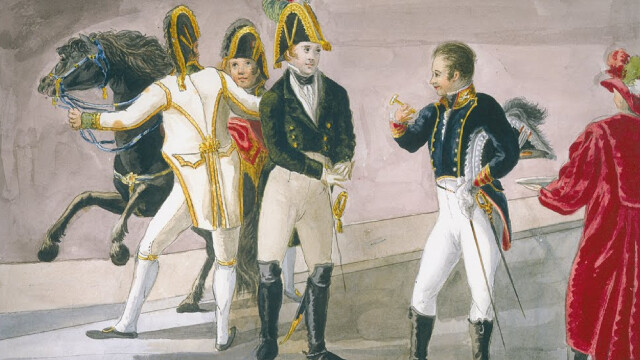
In 1821, Agustín de Iturbide, a royalist military officer who switched sides, successfully negotiated independence through the Plan of Iguala, signed with Vicente Guerrero. This document proclaimed three basic principles, known as the Three Guarantees: Principle, Meaning, Religion — the Catholic religion would be the only one permitted. Independence — Mexico would definitively separate from Spain. Union — Spaniards and Creoles would be considered equal before the law. The Army of the Three Guarantees, commanded by Iturbide, triumphantly entered Mexico City on September 27, 1821, officially ending the war of independence. Thus, the Mexican Empire was born, a constitutional monarchy that sought to imitate European models, especially the Spanish and French. The rise of Agustín de Iturbide to the throne After independence, an attempt was made to establish a stable government under the idea that a constitutional monarch could guarantee unity and peace. After the ceremony, the imperial couple left the Cathedral under a velvet canopy and was acclaimed by the crowd. The composition of the Empire and its brief duration The First Mexican Empire covered a vast territory, inherited from the old viceroyalty, which included the current regions of Mexico, Central America, and part of the southwestern United States. The coronation of Agustín de Iturbide as Emperor of Mexico marked one of the most symbolic and controversial episodes in the nation's history. This event invites us to reflect on: The search for national identity — newly independent Mexico needed a figure to symbolize unity and sovereignty. The dilemma between monarchy and republic — Iturbide's Empire was the country's first political experiment, and its failure led to the consolidation of the Federal Republic. The weight of religion in politics — the choice of the Cathedral and the support of the clergy show the close relationship between faith and power in the nation's early years. The fragility of power — the rapid fall of the empire evidences the political instability that characterized 19th-century Mexico. Final reflection: the echo of a coronation The coronation of Agustín de Iturbide in the Metropolitan Cathedral of Mexico City was not merely a ceremonial act. In the 19th century, he was condemned by republicans, but over the years, historians have recognized his role as the architect of the end of the war and one of the founders of the Mexican state. The Metropolitan Cathedral as a witness to Mexican history The Metropolitan Cathedral of Mexico City, located opposite the Zócalo, has been the stage for some of the country's most transcendent moments: from viceregal ceremonies and funerals of national heroes to major political events. Its monumental architecture, a mix of Baroque, Neoclassical, and Renaissance styles, reflects the evolution of art and faith in Mexico. However, Spain did not recognize independence, and no European monarch accepted the proposal. Faced with a power vacuum and Iturbide's immense prestige — considered by many as the liberating hero — conservative sectors and the army began to promote his coronation as emperor. It represented the first attempt to politically organize a newly liberated country, divided by ideologies and marked by years of war. Some of the most relevant legacies of the imperial period were: Consolidation of independence — The Empire confirmed the definitive separation from Spain. Creation of national symbols — During his government, the first national coat of arms was designed with the eagle on the nopal, inspired by the symbols of the Empire. Establishment of the Constituent Congress — Although temporarily dissolved, this body laid the foundations for the subsequent republican Congress. First steps in Mexican diplomacy — Iturbide sought international recognition for the new state, especially from European powers. However, the lack of administrative experience, personal interests, and tensions between liberals and conservatives prevented the imperial project from prospering. The historical legacy of Agustín de Iturbide The figure of Agustín de Iturbide has been a subject of historical debate. It represented the attempt of a people to consolidate its independence, create its own government, and define its identity. Although his reign was brief and ended tragically, the fact of being crowned in the country's spiritual heart gave it a symbolic dimension that transcends time. The history of that July day in 1822 continues to resonate under the vaults of the Cathedral and in the pages of national history, reminding us that Mexico's independence did not end with the war, but began a complex process of political, social, and cultural construction. The return and tragic death of Iturbide After a brief exile in Italy and later in England, Iturbide returned to Mexico in 1824, convinced that his presence was necessary to defend the country from a possible foreign invasion. However, the Mexican Congress had declared him a traitor and ordered his execution in case he returned to national territory. On July 19, 1824, upon landing in Soto la Marina (Tamaulipas), he was arrested and shot shortly after. This event not only marked the end of the struggle for Independence but also the beginning of a brief monarchical stage that sought to give stability to a newborn nation. To understand where and how Iturbide was crowned, it is essential to know the historical context, the political reasons, and the profound meaning of this act that sought to consolidate the power of the new Mexican nation. The historical context of the First Mexican Empire In the early 19th century, the Viceroyalty of New Spain was going through a profound crisis. This temple, a symbol of religious and political power during the viceroyalty, was chosen for its spiritual and patriotic significance. The choice of the Cathedral was not accidental: it represented the union between the Catholic Church and the new Mexican state, reinforcing the principle of Religion established in the Plan of Iguala. With his death, the chapter of the First Mexican Empire was definitively closed. The symbolism of the coronation in the Metropolitan Cathedral The fact that Iturbide's coronation took place in the Metropolitan Cathedral has a deep symbolic meaning. Its main altar, a witness to viceroys, bishops, and heroes, also saw an emperor who sought to perpetuate his vision of a country united under a single banner. Although the Empire of Iturbide was brief, its impact on the history of Mexico was profound. For some, he was a hero who culminated independence and gave the country a unified identity. This temple represented not only the continuity of religious power but also the divine legitimization of the new political order. In an era when the Catholic religion was the pillar of national identity, the act of crowning an emperor within the country's main church sought to unite the spiritual and the earthly under the same purpose: to consolidate independence and stability. The Metropolitan Cathedral thus became the setting for one of the most emblematic moments in the birth of independent Mexico. Furthermore, its location in the heart of the old capital's Zócalo symbolized the central power of the new nation. During the ceremony, the atmosphere was one of solemnity and splendor. Built on the ruins of the Aztec Templo Mayor, it also represents the country's cultural and religious syncretism. Inside lie the remains of illustrious figures and priceless works of art are preserved. Initially, the Constituent Congress offered the throne to Ferdinand VII or, in his absence, to some member of the Spanish royal family. On May 18, 1822, the people of Mexico City, spurred on by military regiments, acclaimed Agustín de Iturbide as Emperor of Mexico. Two days later, the Congress officially ratified his appointment with the title of Agustin I. The place of coronation: the Metropolitan Cathedral of Mexico City The coronation of Agustín de Iturbide took place on July 21, 1822, in the majestic Metropolitan Cathedral of Mexico City. Although his reign was short, his influence remained in the symbols and national memory. Over time, his figure has been reinterpreted. However, its existence was ephemeral: it lasted less than a year. The causes of his fall were multiple: Political discontent — many deputies and leaders viewed with suspicion the concentration of power in Iturbide's hands. Economic problems — the country was in ruins after the war and there were not enough resources to sustain a monarchy. Conflicts with the Congress — Iturbide dissolved the Congress, considering it a threat to his authority, which caused an institutional crisis. Military uprisings — several provinces rebelled in defense of the republican system. In March 1823, the Plan of Casa Mata, promoted by Antonio López de Santa Anna and Guadalupe Victoria, demanded the restoration of the Congress and the establishment of a republic. After more than a decade of war begun in 1810 by Miguel Hidalgo y Costilla, the territory was devastated and fragmented. Iturbide was accompanied by his wife, Ana María Huarte de Iturbide, who was also crowned as empress. During the mass, the archbishop placed a gold crown on Iturbide's head, a symbol of imperial power and authority. For others, he was an ambitious military man who betrayed republican ideals and sought to establish a personalist monarchy. His coronation in the Metropolitan Cathedral symbolizes the ambition of a people that yearned for stability after years of chaos. The ceremony was presided over by Archbishop Pedro José de Fonte, who officiated the solemn mass. The emperor wore a crimson velvet mantle embroidered in gold, while the empress wore a white dress and blue mantle, adorned with precious stones. The act was accompanied by sacred music, bell ringing, and artillery salutes. Thousands of people gathered to witness the event that was intended to mark the birth of a new era. Details of the imperial ceremony The coronation was a carefully planned ceremony to reflect the grandeur of the new empire. Iturbide abdicated on March 19, 1823, and went into exile in Europe. The return and tragic death of Iturbide After a brief exile in Italy and subsequently in England, Iturbide returned to Mexico in 1824, convinced that his presence was necessary to defend the country from a possible foreign invasion. The nearby streets were decorated with flowers, tapestries, and tricolor flags.













